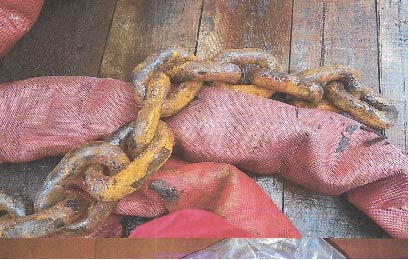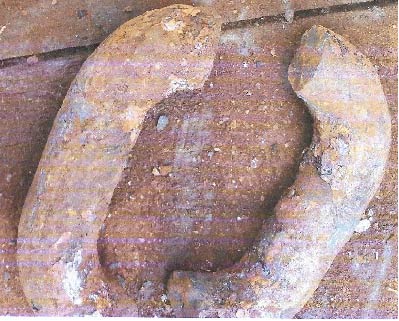Hyperbaric lifeboat emergency lifting chain link failure
A member has reported an incident in which a chain parted during the recovery of a hyperbaric lifeboat (HLB) during ‘routine’ testing and maintenance. On recovery of the HLB the vessel crane started the lift and when the weight on the crane load readout was approximately 7 tonnes, one leg of the chain set parted when two links split through their link ends. Since the HLB had not yet been fully lifted out of the water the drop was minimal and the parted chain dropped back onto the top of the HLB. There was no damage to the HLB shell due to the soft covering over the chain links.



Our member’s investigation noted the following:
- Periodic inspections of the chain were in date and on record;
- Significant corrosion was discovered on the chain, raising concern about the pass/fail criteria used on the previous visual inspection;
- The cross section of the failure locations revealed corrosion indicating the presence of cracks prior to failure;
- The protective covering is a potential obstruction to thorough and effective inspection of the individual chain links;
- Environmental conditions at the time of the incident were stable and could not have contributed to high impact loads;
- The chain set has been returned to the manufacturer for mechanical testing and analysis. The results of this testing are pending.
Our member took the following immediate corrective actions:
- Stopped the job;
- Lifted the HLB back in its original position using the davit system;
- The chain set was removed and quarantined.
The following remedial actions were suggested by our member:
- All HLB lifting chain sets should be re-inspected by full removal of the protective covering to gain complete access to each link for a thorough visual inspection;
- The inspection should be conducted by an authorised authority against an acceptable industry standard of acceptance criteria with emphasis on wear, cracks, pitting and corrosion.
NB Further remedial actions pending the outcome of the manufacturer’s investigation may be available in due course.
Members may wish to refer to the following incidents (search words: chain, link, failure)
Safety Event
Published: 10 August 2016
Download: IMCA SF 21/16
IMCA Safety Flashes
Submit a Report
IMCA Safety Flashes summarise key safety matters and incidents, allowing lessons to be more easily learnt for the benefit of all. The effectiveness of the IMCA Safety Flash system depends on Members sharing information and so avoiding repeat incidents. Please consider adding [email protected] to your internal distribution list for safety alerts or manually submitting information on incidents you consider may be relevant. All information is anonymised or sanitised, as appropriate.
IMCA’s store terms and conditions (https://www.imca-int.com/legal-notices/terms/) apply to all downloads from IMCA’s website, including this document.
IMCA makes every effort to ensure the accuracy and reliability of the data contained in the documents it publishes, but IMCA shall not be liable for any guidance and/or recommendation and/or statement herein contained. The information contained in this document does not fulfil or replace any individual’s or Member's legal, regulatory or other duties or obligations in respect of their operations. Individuals and Members remain solely responsible for the safe, lawful and proper conduct of their operations.
